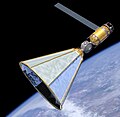 | A geosynchronous orbit (sometimes abbreviated GSO) is an Earth-centered orbit with an orbital period that matches Earth's rotation on its axis, 23 hours... 32 KB (3,171 words) - 19:30, 12 March 2024 |
This is a list of satellites in geosynchronous orbit (GSO). These satellites are commonly used for communication purposes, such as radio and television... 65 KB (729 words) - 23:00, 25 April 2024 |
 | Thus, a geostationary orbit is defined as a geosynchronous orbit at zero inclination. Geosynchronous (and geostationary) orbits have a semi-major axis... 31 KB (3,471 words) - 19:19, 24 February 2024 |
Space elevator (redirect from Geosynchronous orbital tether) without the use of large rockets. The concept of a tower reaching geosynchronous orbit was first published in 1895 by Konstantin Tsiolkovsky. His proposal... 87 KB (10,333 words) - 17:57, 18 April 2024 |
 | graveyard orbit is a supersynchronous orbit well beyond geosynchronous orbit. Some satellites are moved into such orbits at the end of their operational life... 8 KB (1,007 words) - 01:03, 3 May 2024 |
 | A geosynchronous satellite is a satellite in geosynchronous orbit, with an orbital period the same as the Earth's rotation period. Such a satellite returns... 9 KB (1,035 words) - 16:39, 24 May 2023 |
200 mi) and that of the geosynchronous orbit at 35,786 km (22,236 mi). Geosynchronous orbit (GEO) Geocentric circular orbit with an altitude of 35,786 km... 17 KB (1,997 words) - 05:12, 1 March 2024 |
have an inclined orbit around the Sun if it has an angle other than 0° to the ecliptic plane. A geosynchronous orbit is an inclined orbit with an altitude... 2 KB (338 words) - 00:00, 12 January 2023 |
areosynchronous orbits (ASO) are the synchronous orbits for artificial satellites around the planet Mars. They are the martian equivalent of the geosynchronous orbits... 3 KB (377 words) - 22:19, 30 July 2023 |
 | the boundary between MEO and HEO is the particular altitude of a geosynchronous orbit, in which a satellite takes 24 hours to circle the Earth, the same... 9 KB (989 words) - 23:33, 27 April 2024 |
Altitude (section In satellite orbits) 200 mi) and that of the geosynchronous orbit at 35,786 km (22,236 mi). Geosynchronous orbit (GEO) Geocentric circular orbit with an altitude of 35,786 km... 25 KB (3,004 words) - 19:29, 5 May 2024 |
 | than would be required from a geosynchronous orbit. Low Earth orbit A low Earth orbit (LEO) typically is a circular orbit about 160 to 2,000 kilometres... 49 KB (5,935 words) - 22:27, 25 April 2024 |
 | Tundra orbit (Russian: орбита «Тундра») is a highly elliptical geosynchronous orbit with a high inclination (approximately 63.4°), an orbital period of... 17 KB (1,703 words) - 18:00, 6 August 2023 |
 | 2014 on-board PSLV-C24 rocket. The satellite has been placed in geosynchronous orbit. IRNSS-1C was launched on 16 October 2014, IRNSS-1D on 28 March 2015... 54 KB (4,433 words) - 15:22, 25 April 2024 |
 | A high Earth orbit (HEO) is an Earth-centered orbit with altitude at apogee higher than that of the geosynchronous orbit (35,786 km above sea level )... 6 KB (565 words) - 11:25, 17 March 2024 |
 | Space-based solar power (redirect from Orbital power satellite) electricity. The program looked both at systems in Sun-synchronous orbit and geosynchronous orbit. Some of SERT's conclusions: The increasing global energy demand... 111 KB (12,671 words) - 23:15, 6 May 2024 |
 | Outer space (section Earth orbit) concept used by the US to refer to space of high Earth orbits, ranging from beyond geosynchronous orbit (GEO) at approximately 35,786 km (22,236 mi), out to... 134 KB (13,190 words) - 09:56, 4 May 2024 |
 | Starlink (redirect from Proliferated Low Earth Orbit program) plans with the FCC to field a second orbital shell of more than 7,500 "V-band satellites in non-geosynchronous orbits to provide communications services"... 266 KB (22,530 words) - 05:12, 9 May 2024 |
 | Geosynchronous Satellite Launch Vehicle (GSLV) is a class of expendable launch systems operated by the Indian Space Research Organisation (ISRO). GSLV... 25 KB (1,800 words) - 14:18, 29 April 2024 |
geostationary orbit. The more general case, when the orbit is inclined to Earth's equator or is non-circular is called a geosynchronous orbit. The corresponding... 5 KB (574 words) - 11:48, 2 May 2024 |
 | NASA (section First orbital and hypersonic flights) with satellites in low earth orbit (LEO), geosynchronous orbit (GEO), highly elliptical orbits (HEO), and lunar orbits. The NSN accumulates ground station... 222 KB (20,710 words) - 03:39, 9 May 2024 |
all objects in Earth orbit. The 19th Space Defense Squadron focuses on objects further in cislunar space, beyond geosynchronous orbit, with a specific focus... 210 KB (17,684 words) - 16:33, 7 May 2024 |
 | Ground track (section Effect of orbital period) of its orbit closest to perigee, and westward when it is closest to apogee. A special case of the geosynchronous orbit, the geostationary orbit, has an... 14 KB (1,964 words) - 16:04, 15 April 2024 |
orbits (GEO), 10 in 55° inclined geosynchronous orbits (IGSO) and 27 in Medium Earth orbits (MEO). Furthermore, 8 satellites (4 in Medium Earth orbit... 23 KB (442 words) - 04:27, 6 May 2024 |






